Baegunsan Recreational Forest (백운산자연휴양림)
16.7Km 2024-02-01
337 Baekgye-ro, Gwangyang-si, Jeollanam-do
+82-61-797-2655
Located in Baegunsan Mountain is a recreational forest that is a testament to Korea's rich ecosystem. Home to many rare fauna and flora, the area brims with diverse attractions. Come springtime, visitors can find the maple sap, a mineral-rich liquid from a local deciduous tree of the maple family, known for its medicinal benefits. Indeed, this is a recreational forest cradled in the arms of nature. With the towering Baegunsan peak, scaling 1,222 meters, as its crown jewel, the landscape unfolds like a tapestry woven with harmonious blends of man-made and natural pine forests. Journey through the cedar and cypress woods, and one will find the valley that evokes sheer wonder. Close by, history whispers through the ancient Ongnyongsa Temple Site, where Doseonguksa dedicated 35 years to ascetic practices. As February turns to March, over 7,000 camellias blossom around this sacred site, painting the area in vibrant hues.
Baemsagol Jirisan Sikdang (뱀사골 지리산식당)
18.1Km 2024-04-07
271 Jirisan-ro, Sannae-myeon, Namwon-si, Jeonbuk-do
+82-63-626-8800
Baemsagol Jirisan Sikdang specializes in baeksuk (whole chicken soup) and heukdwaeji gui (grilled black pork). They prepare healthy dishes using wild vegetables and traditional Korean medicinal ingredients collected from Jirisan Mountain. In addition to bibimbap and acorn jelly salad, they also offer dishes like grilled deodeok. Visitors can also enjoy their meals on the outdoor tables set up by Dalgunggyegok Valley.
Yeoyeo Sikdang (여여식당)
18.2Km 2025-01-22
92 Gyeongseo-daero, Hadong-eup, Hadong-gun, Gyeongsangnam-do
055-884-0080
If you want to get the basics of jaecheop (Freshwater Marsh Clam) dishes in the Hadong-eup center area, head to Yeoyeo Sikdang. This restaurant serves a rich bowl of jaecheop-guk with a good selection of side dishes and a bowl of steamed rice.
Buheung Jaecheop Sikdang (부흥재첩식당)
18.3Km 2025-01-22
98 Gyeongseo-daero, Hadong-eup, Hadong-gun, Gyeongsangnam-do
055-884-3903
Like many other restaurants in Hadong, this restaurant serves freshwater marsh clam dishes. The restaurant is most famous for jaecheophoe (raw freshwater marsh clam). This dish is served on a bed of pear, carrot, cabbage, cucumber, and other vegetables tossed with sweet and sour red chili paste. Another popular menu is the Modum Jeongsik (assorted freshwater marsh clam set menu), which has jaecheopguk, jaecheopjeon, and jaecheophoe.
Baemsagol Waun Village (뱀사골 와운마을)
18.4Km 2024-04-07
249 Waun-gil, Namwon-si, Jeonbuk-do
Baemsagol Waun Village is located deep in the heart of Jirisan Mountain, being almost impossible to find if one didn't know the pathway in the past. The village is located within a 14 kilometer-long valley with many strangely shaped rocks. The village is home to an old pine tree (Natural Monument) that is lovely referred to as "Grandmother Tree."
Hadong Pine Forest (하동송림)
18.4Km 2021-07-21
2107-8, Seomjingang-daero, Hadong-gun, Gyeongsangnam-do
+82-55-880-2651
Hadong Pine Forest grows along the Seomjingang River near Seomjingang Iron Bridge. It was planted in 1745, during the 21st year of Joseon King Yeongjo’s reign, to block wind and sand. Now, it is one of the best pine groves in Korea.
In a total area of 26,000 ㎡ are approximately 750 old-growth pine trees. Along with the white sand on the riverside, the forest provides picturesque scenery when seen from Hasangjeong Pavilion within the forest. The forest park is used as a venue for folk games and major events hosted by the local government. There are sports facilities and recreational facilities teenagers, children, and families can enjoy, attracting many locals and tourists.
Jirisan Manbokdae Peak (지리산 만복대)
19.6Km 2021-02-05
Sandong-myeon, Gurye-gun, Jeollanam-do
+82-61-780-7700
Manbokdae Peak in the west soars at the boundary between Sandong-myeon, Gurye-gun and Namwon-si at 1,433.4 meters above sea level. ”Man” means “full of something” and “bok” means “fortune.” Like the name, Manbokdae is considered as a fortunate mountain with great views as it is surrounded by smooth hills. According to an old story, Manbokdae Peak was chosen as one of the 10 scenic areas, where people come to receive good fortune.
Dalgunggyegok Valley (달궁계곡)
19.6Km 2024-04-07
Jirisan-ro, Sannae-myeon, Namwon-si, Jeonbuk-do
Dalgunggyegok Valley is a valley located within the Jirisan National Park. It spans 6 kilometers from Dalgung Village to Simwon Village. Surrounded by dense primeval forests, it showcases the pristine beauty of an untouched valley where human hands have yet to reach. The combination of the valley and cliffs creates stunning scenery. Nearby Dalgung Village also preserves remnants of ancient Mahan palaces.
Jirisan Chilseongyegok Valley (칠선계곡(지리산))
19.8Km 2022-07-29
Chuseong-ri, Hamnyang-gun, Gyeongsangnam-do
+82-55-970-1000
Chilseongyegok Valley is the most beautiful valley in Jirisan Mountain, and is one of the top three valleys in the nation, along with Cheonbuldonggyegok Valley in Seoraksan Mountain and Tamnagyegok Valley in Hallasan Mountain. The 16-kilometer valley stretching from Uitan of Macheon-myeon to Cheonwangbong Peak is characterized by very tough topography but beautiful scenery and is the only remaining primeval forest of Jirisan Mountain. It is also dotted with seven waterfalls and 33 ponds. The hike becomes more difficult as the trail enters the valley. Because the valley has taken many lives, some people call it "The Valley of Death." For that reason, visitors must apply in advance and hike with a guide. The trail in Chilseon Valley is a 9.4-kilometer course from Chuseong Village in Macheon-myeon to Cheonwangbong Peak, which does not follow the natural valley, due to the valley's steep and dangerous features. Starting from Chuseong Village, the trail passes Yongso Pond, Jujiteo Site, Chuseongmang Rock, Seonnyeotang Pond, Ongnyeotang Pond, Biseondam, Chilseonpokpo Falls, Daeryukpokpo Falls, Samcheungpokpo Falls and Mapokpo Falls, all before reaching Cheonwangbong Peak.
Jirisan National Park (Hamyang Section) (지리산국립공원(함양))
19.8Km 2021-02-05
Baengmudong-ro, Hamyang-gun, Gyeongsangnam-do
+82-55-970-1000
Designated as the first national park in Korea on December 29, 1967, Jirisan National Park stretches out over 483.022 square kilometers, making it the largest national park among all 22 national parks. It covers Korea’s three southernmost provinces; Gyeongsangnam-do, Jeollanam-do, and Jeollabuk-do, one city, four counties, and 15 districts of eup and myeon. The area in Gyeongsangnam-do has Ssanggyesa Temple, Daewonsa Temple, Beopgyesa Temple, Chilbulsa Temple, and Chilsangsa Temple as well as valleys, falls, and other tourism resources. In particular, famous tourist spots in Hamyang area are Chilseongyegok Valley and Hansingyegok Valley.


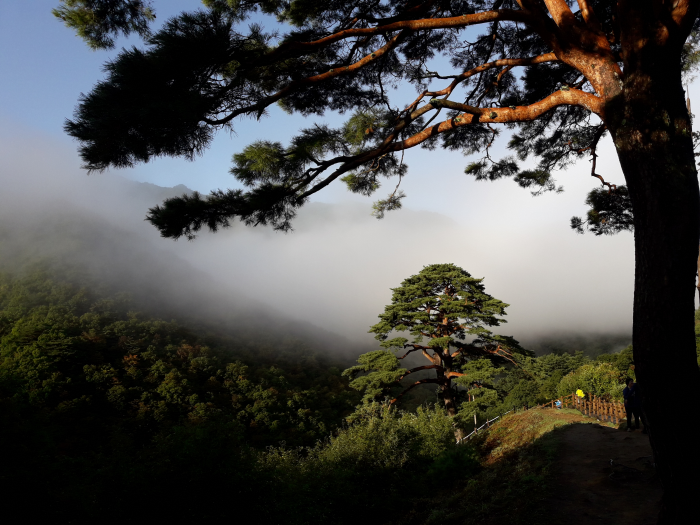
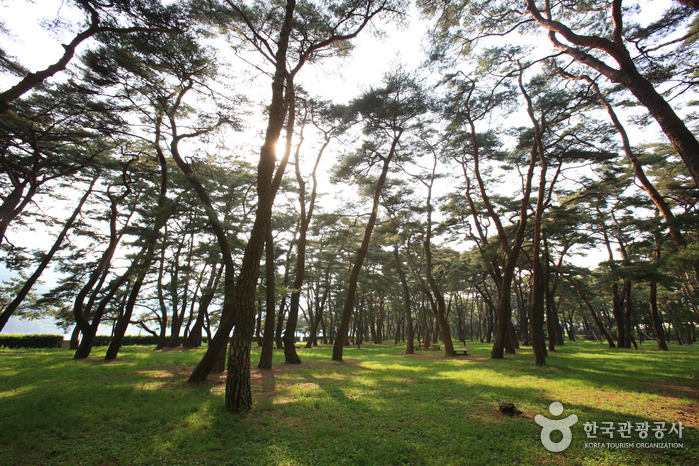
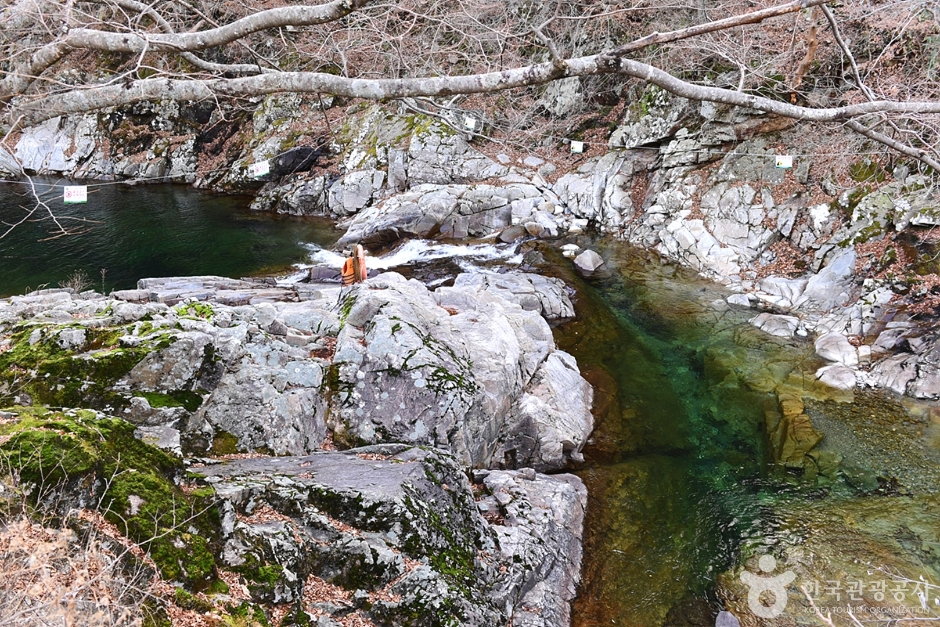
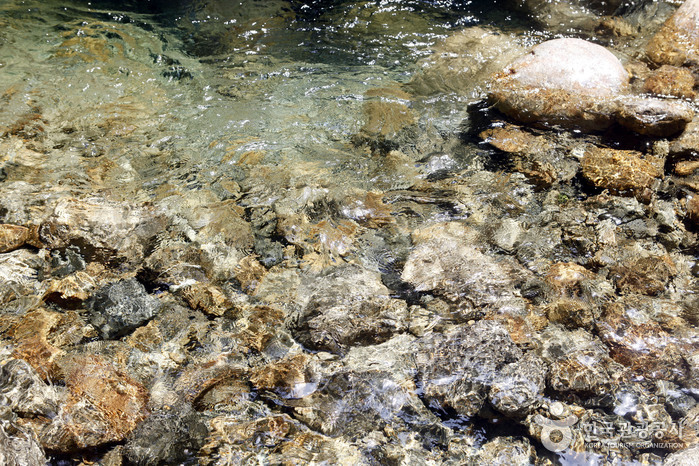
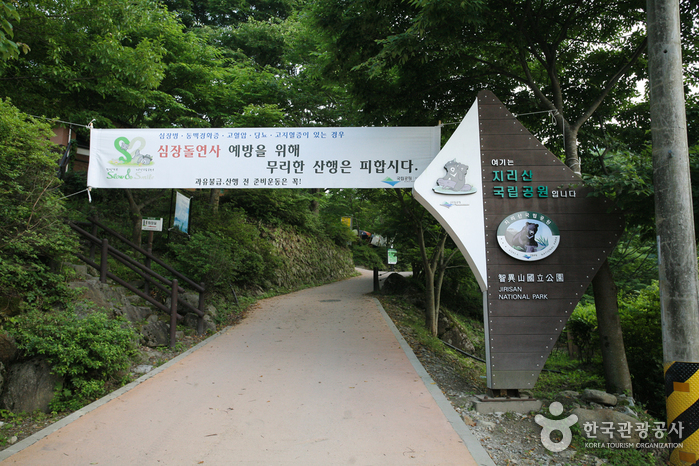
 English
English
 한국어
한국어 日本語
日本語 中文(简体)
中文(简体) Deutsch
Deutsch Français
Français Español
Español Русский
Русский